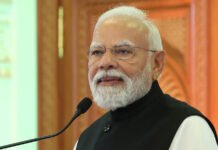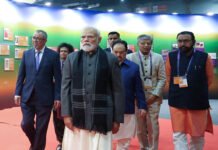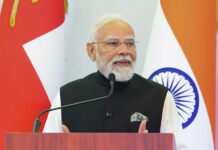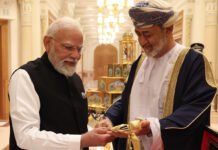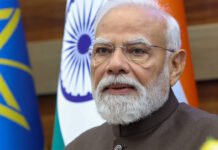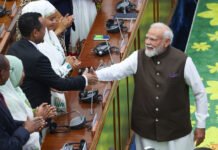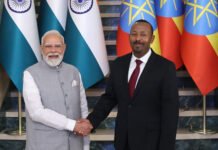In a surprising turn of events, Vice President Jagdeep Dhankhar’s resignation has thrown the Indian political landscape into a whirlwind. The vacancy in the second-highest constitutional office has not only jolted the central government but also invigorated the opposition. Now, as Parliament faces mounting tensions, the pressing question looms large: Who will be the next Vice President of India?
With strategic meetings taking place at the highest levels—featuring Prime Minister Narendra Modi, Home Minister Amit Shah, Defense Minister Rajnath Singh, and Uttar Pradesh Chief Minister Yogi Adityanath—speculation about sweeping political changes is gaining momentum. The ongoing BJP presidential transition, a possible cabinet reshuffle, and the need to maintain North-South political balance are all converging on this critical juncture.
Yogi Adityanath’s Meetings Fuel Buzz About Major Changes in UP
Chief Minister Yogi Adityanath’s back-to-back meetings with top BJP leadership have ignited fresh talk of a reshuffle in Uttar Pradesh, India’s most politically consequential state. His private discussions with PM Modi, Amit Shah, Rajnath Singh, and BJP national president JP Nadda are being seen as early moves in a broader 2027 UP Assembly election strategy.
Importantly, Deputy Chief Ministers of UP have also met central leaders, further solidifying the theory that big structural shifts could be imminent. These moves signal that the BJP is leaving no stone unturned in its bid to secure continued dominance in both state and national politics.
The Urgency: Why the Vice President’s Post Matters More Than Ever
The Vice President of India serves as the ex-officio Chairman of the Rajya Sabha, a role of increasing importance for a government that currently lacks an absolute majority in the Upper House. Critical bills—especially those involving economic reforms and national security—often face obstruction in the Rajya Sabha. A neutral or opposition-aligned Vice President could hamper the government’s legislative momentum.
Hence, the selection of the new Vice President is not merely ceremonial—it is a strategic imperative. The BJP must balance experience, loyalty, and cross-party acceptability to ensure smooth passage of its parliamentary agenda.
BJP’s Internal Equation: JP Nadda’s Tenure in Limbo, President Selection Stalled
Another pressure point within the ruling party is the overdue election of a new BJP national president. JP Nadda’s extended term has created a vacuum at the top of the party’s organizational hierarchy. No clear successor has emerged, even as names from both North and South India are being floated.
This leadership uncertainty has had a domino effect, delaying the selection of state-level presidents in politically critical regions such as Uttar Pradesh and Delhi. The unresolved state of the BJP’s internal machinery further complicates the decision-making process around the Vice President’s post.
Balancing the North-South Power Equation: A Tactical Opportunity
With ambitions to expand deeper into South India, the BJP must craft a delicate balance between reinforcing its traditional Northern strongholds and nurturing new support bases in the South. Sources indicate that while a party president from the South is being considered, the Vice President’s position may be used to counterbalance this move.
There is widespread belief within political circles that a Southern leader may be chosen as Vice President to signal inclusivity and strengthen the BJP’s appeal in states like Tamil Nadu, Andhra Pradesh, Telangana, and Kerala, where the party’s footprint remains modest.
This strategy would allow the BJP to retain control in North India—possibly through a president from the Hindi heartland—while projecting national inclusivity through a Southern Vice President.
Allies Hold the Leverage: JD(U) and TDP Seek Larger Roles
The BJP’s current reliance on key allies like Nitish Kumar’s JD(U) and Chandrababu Naidu’s TDP has added another dimension to the Vice President selection. Both allies are critical to maintaining a parliamentary majority, especially in the Rajya Sabha.
With increasing assertiveness from coalition partners, the Vice President’s post may emerge as a bargaining chip. JD(U), in particular, has long expressed the desire to hold a constitutional office of national significance. Likewise, TDP is likely to push for greater representation following its strong performance in Andhra Pradesh.
Balancing coalition dynamics, regional aspirations, and party unity will be a tough political challenge for the BJP-led government.
Who Are the Likely Candidates for Vice President?
As speculation swirls, several names are doing the rounds as potential contenders for the vacant Vice President’s position. These include:
Anandiben Patel: The current Governor of Uttar Pradesh and a trusted Modi aide, her elevation could ensure both loyalty and experience.
Thaawarchand Gehlot: Karnataka Governor and a senior Dalit leader, Gehlot’s name has come up as a possible South Indian face.
Sushil Kumar Modi: The former Bihar Deputy CM could help cement BJP-JD(U) ties if offered the Vice Presidency.
Venkaiah Naidu (return): While unlikely, some believe that the seasoned leader could be asked to return as a consensus candidate.
K. Laxman: As BJP OBC Morcha president and a Telangana leader, his name aligns with both caste and Southern strategy goals.
Timing Is Critical: Session Pressure and Political Optics
The ongoing Parliamentary session has intensified pressure on the government to announce a suitable candidate swiftly. Every day the Vice President’s chair remains vacant, the opposition grows louder in its criticism, portraying the ruling alliance as disorganized and unprepared.
The BJP, therefore, must make a strategic yet timely choice, one that reassures allies, sends a national signal of inclusivity, and restores momentum in Parliament. The optics of this decision will shape political narratives heading into the 2026 state elections and ultimately the 2029 General Elections.
Will UP See a Major Cabinet Overhaul Too?
In parallel, strong rumors suggest that Uttar Pradesh may undergo a cabinet expansion or reshuffle. With CM Yogi’s frequent visits to Delhi and meetings with the top brass, there is chatter that new Deputy Chief Ministers could be inducted, or key portfolios reshuffled to energize the state government.
The changes in UP could serve a dual purpose: strengthening the state administration in preparation for the 2027 Assembly elections and creating vacancies that allow senior leaders to transition into national roles, including constitutional positions like the Vice President.
Conclusion: A Defining Moment in Indian Politics
As the country awaits the announcement of the next Vice President of India, the BJP is walking a tightrope. With internal restructuring, regional calculations, alliance demands, and legislative priorities all converging, this decision is about much more than just filling a vacancy.
It is a litmus test for the Modi government’s political foresight, its ability to manage competing ambitions, and its commitment to national integration. Whether the next Vice President comes from the North or South, within the BJP or an ally, this choice will reshape the political contours of India for years to come.


